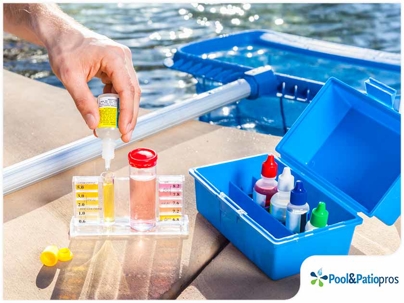Swimming pools are an excellent outlet for recreation and fitness. They’re a simple, yet significant addition to our homes due to how much they can contribute to our health, most importantly, to our cardiovascular system in particular. On a hot summer day, most people think of basking in a pool to escape the summer heat. It’s also a great spot to enjoy with your friends and family!
We wouldn’t blame you if you thought that it’s as simple as filling up the pool to the brim and leaving it as it is. But your pool requires regular maintenance and services to ensure that it’s safe and clean to swim. It requires thorough planning and smooth execution to ensure that it’s pulled off correctly. Of course, this can be made possible if you’re working with top-notch pool maintenance and repair experts like Pool and Patio Pros.
Even if the process of filling up the pool remains simple on the surface, chemicals and other materials are required to be mixed in to prevent the growth of algae, bacteria, or other contaminants. Without treatments, your pool can become a vicious breeding ground for various kinds of contaminants and organisms. Granted, it may be tedious and time-consuming, but it’s necessary to ensure the safety of your pool so you can enjoy it to the fullest.
Today, we share a comprehensive guide on pool chemicals and what they do to keep your home’s pool safe for you to swim in throughout the year.
What Are Pool Chemicals?
The first thing that you might think of is that chemicals are harmful to your body. You might even be concerned about it since you’re swimming in it. However, you should keep in mind that these chemicals are essential in keeping your pool sanitary and free of contaminants as we use the safest options so that you can utilize your pool to the fullest.
You can fill up your pool with fresh, clean water, and skim through it with a vacuum every day, but the water will remain dirty. This is because leaves, twigs, and debris can fall into your pool. Insects can find their way into it as well as bird droppings. Also, every time someone swims, our body’s byproducts like body oils, dead skin, hair, shampoo, and soap can leave residue on our pools daily. One of the most important things that prevent your pool from becoming a cesspool are sanitizers and chemicals.
This is why pool repair and service experts ensure that the water’s pH levels, alkalinity, and calcium hardness are in a balanced state so that the sanitizers are fully effective. Lastly, the chemicals are added to treat algae to clear your pool and prevent staining. All of these work in harmony so that you can swim freely.
Sanitizer
There are multiple kinds of sanitizers, but their main function is to keep your water sanitized and disinfected. There should be a constant level of chlorine or bromine in the pool water at all times without too many changes so that the other factors, such as pH levels and alkalinity, aren’t affected.
Some of the sanitizers used include:
- Trichlor: Your pool maintenance expert can use the three-inch tablets or one-inch tablets with sticks that have cyanuric acid. Make sure to add them to a chlorine floater or an integrated chlorinator.
- Dichlor: This is a granular sanitizer that also has cyanuric acid. It comes in a powdered form that can be easily absorbed to chlorinate pools, fountains, or even spas.
- Bromine: Bromine comes with one-inch tabs that are ideal for pools with warm to hot water. It can be regenerated by shocking it. It also makes the pH levels in your swimming pool more stable as well.
- Cyanuric acid: This is also known as a liquid or dry chlorine stabilizer. It protects the chlorine in your pool against harmful ultraviolet (UV) rays. Small amounts are added to dichlor and trichlor as well.
Oxidizers
Oxidizers serve as a secondary sanitizer. These are added to your pool once every few weeks to rid it of algae and bacteria. They come in chlorine or non-chlorine shocks in powdered form. You simply open up the bag and pour it into the pool. If you have a pool with low pH levels (for example, 7.2), then calcium hypochlorite is a great option.
This pool shock can quickly sanitize your pool water, bolster chlorine levels, and kill algae and other contaminants. Another great option is chlorine-free shock which comes in granular form. It’s a quick-reaction oxygen-based sanitizer that cleans your pool without any residue. You can swim right after you pour it!
Water Balancers
To keep the water in your pool in check, you’ll need to test the waters literally at least three times a week to inspect their chlorine and pH levels. Don’t forget to test the alkalinity levels, calcium hardness, and cyanuric acid levels as well every month.
Here are some of the additives you can get, depending on what’s needed for your swimming pool:
- pH Increaser: If you find out that your pH levels are low, you can add granular soda ash when they fall below 7.2 parts per million (ppm). A pound of this mixture can raise your pool’s level by 0.1.
- pH Reducer: You can add a granular sodium bisulfate or dry acid to reduce the pH levels and alkalinity if it exceeds 7.6 ppm.
- Alkalinity increaser: If the alkaline levels are below 80 ppm, you can add granular sodium bicarbonate to keep them leveled.
Are you looking for the top name in pool services and maintenance? Look no further than Pool and Patio Pros! We do weekly pool services, repairs, and resurfacing as well as full pool remodeling! We take the guesswork out of cleaning, updating, and maintaining your pool. Trust in our skilled technicians to take care of all your needs!

